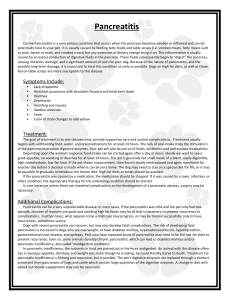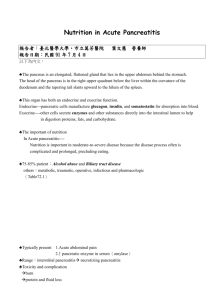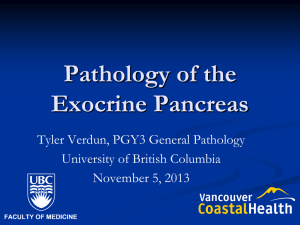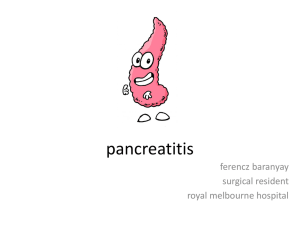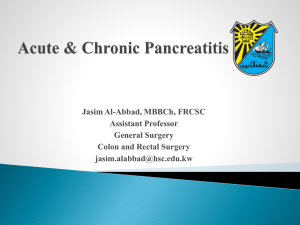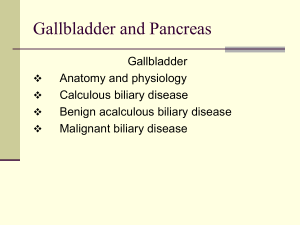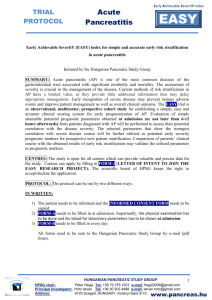Lindquist: Clinical Sonography and Pancreatitis
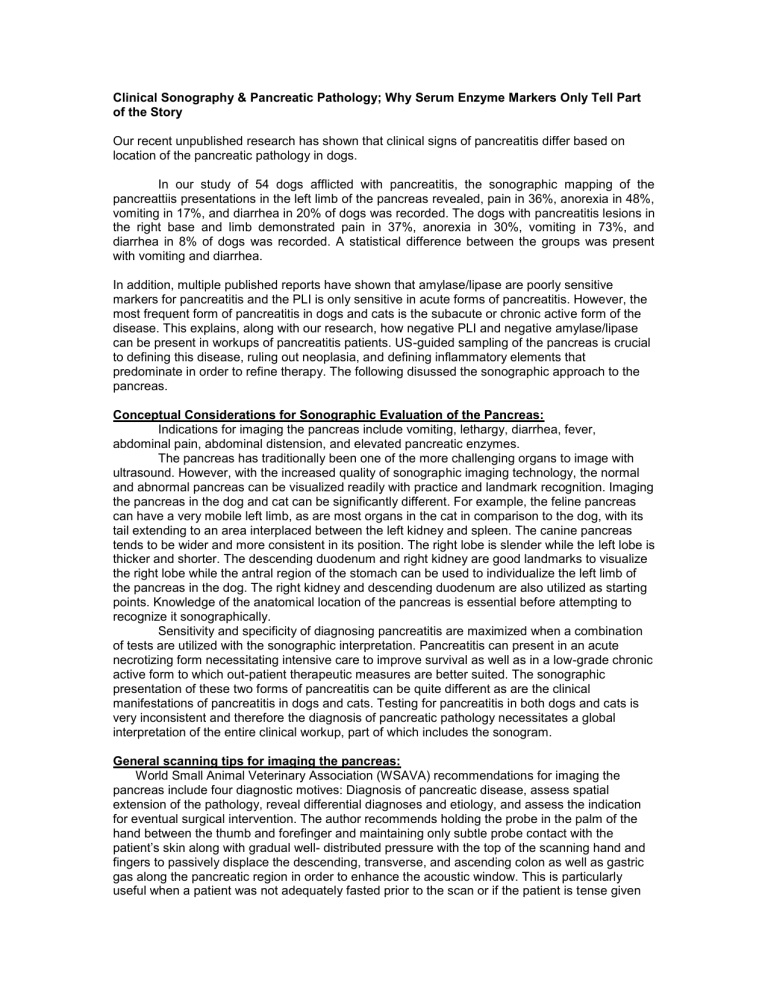
Clinical Sonography & Pancreatic Pathology; Why Serum Enzyme Markers Only Tell Part of the Story
Our recent unpublished research has shown that clinical signs of pancreatitis differ based on location of the pancreatic pathology in dogs.
In our study of 54 dogs afflicted with pancreatitis, the sonographic mapping of the pancreattiis presentations in the left limb of the pancreas revealed, pain in 36%, anorexia in 48%, vomiting in 17%, and diarrhea in 20% of dogs was recorded. The dogs with pancreatitis lesions in the right base and limb demonstrated pain in 37%, anorexia in 30%, vomiting in 73%, and diarrhea in 8% of dogs was recorded. A statistical difference between the groups was present with vomiting and diarrhea.
In addition, multiple published reports have shown that amylase/lipase are poorly sensitive markers for pancreatitis and the PLI is only sensitive in acute forms of pancreatitis. However, the most frequent form of pancreatitis in dogs and cats is the subacute or chronic active form of the disease. This explains, along with our research, how negative PLI and negative amylase/lipase can be present in workups of pancreatitis patients. US-guided sampling of the pancreas is crucial to defining this disease, ruling out neoplasia, and defining inflammatory elements that predominate in order to refine therapy. The following disussed the sonographic approach to the pancreas.
Conceptual Considerations for Sonographic Evaluation of the Pancreas:
Indications for imaging the pancreas include vomiting, lethargy, diarrhea, fever, abdominal pain, abdominal distension, and elevated pancreatic enzymes.
The pancreas has traditionally been one of the more challenging organs to image with ultrasound. However, with the increased quality of sonographic imaging technology, the normal and abnormal pancreas can be visualized readily with practice and landmark recognition. Imaging the pancreas in the dog and cat can be significantly different. For example, the feline pancreas can have a very mobile left limb, as are most organs in the cat in comparison to the dog, with its tail extending to an area interplaced between the left kidney and spleen. The canine pancreas tends to be wider and more consistent in its position. The right lobe is slender while the left lobe is thicker and shorter. The descending duodenum and right kidney are good landmarks to visualize the right lobe while the antral region of the stomach can be used to individualize the left limb of the pancreas in the dog. The right kidney and descending duodenum are also utilized as starting points. Knowledge of the anatomical location of the pancreas is essential before attempting to recognize it sonographically.
Sensitivity and specificity of diagnosing pancreatitis are maximized when a combination of tests are utilized with the sonographic interpretation. Pancreatitis can present in an acute necrotizing form necessitating intensive care to improve survival as well as in a low-grade chronic active form to which out-patient therapeutic measures are better suited. The sonographic presentation of these two forms of pancreatitis can be quite different as are the clinical manifestations of pancreatitis in dogs and cats. Testing for pancreatitis in both dogs and cats is very inconsistent and therefore the diagnosis of pancreatic pathology necessitates a global interpretation of the entire clinical workup, part of which includes the sonogram.
General scanning tips for imaging the pancreas:
World Small Animal Veterinary Association (WSAVA) recommendations for imaging the pancreas include four diagnostic motives: Diagnosis of pancreatic disease, assess spatial extension of the pathology, reveal differential diagnoses and etiology, and assess the indication for eventual surgical intervention. The author recommends holding the probe in the palm of the hand between the thumb and forefinger and maintaining only subtle probe contact with the patient’s skin along with gradual well- distributed pressure with the top of the scanning hand and fingers to passively displace the descending, transverse, and ascending colon as well as gastric gas along the pancreatic region in order to enhance the acoustic window. This is particularly useful when a patient was not adequately fasted prior to the scan or if the patient is tense given
that gradual well-distributed passive pressure may assist in the detection of sensitive regions.
Manual manipulation of interfering organs while scanning enhances the ability to detect patient discomfort associated with the organ imaged at that moment. In addition, in today’s technological era where the ultrasound probes and their footprints are becoming smaller, the wide distribution of pressure onto the patient tends to allow for a more relaxing and fruitful scan as opposed to a
“poke and prod” session that is often poorly tolerated. The patient’s discomfort due to pancreatic inflammation, that can often be quite localized and regional, can lead the sonographer into subtle sonographic presentations of ill-defined parenchyma that may indicate inflammation or other pathology.
Landmarks for imaging the pancreas include the portal vein, duodenum, and stomach.
Normally the pancreas is isoechoic to surrounding fat and slightly more echo dense than the liver in both the dog and cat. In the cat, the body of the left limb is more easily visualized than the right, while the right is more easily recognized than the left in the dog. The left limb of the pancreas is found medial to the spleen and continues cranially towards the body which is found caudal to the greater curvature of the stomach ventral to the portal vein. The spleen provides a scanning window to visualize the left limb, while the presence of gastric fluid allows for better visualization of the body.
The author targets the dual hyperechoic lin es (“railroad track” appearance) of the pancreatic duct in order to identify central portion of the pancreas. Negative color flow uptake on Doppler assessment can be used to differentiate this structure from the pancreato-duodenal vein. The pancreatic duct transects the pancreatic parenchyma while the hyperechoic thin lines that represent the pancreatic capsule are found in an equidistant position medially and laterally from the pancreatic duct. The right medial liver and right kidney provides a nice scanning window for the right pancreatic limb. Following the pancreatic duct as a central focal point in the middle of the parenchyma the pancreatic parenchyma can be followed along its “boomerang” contour in the cranial abdomen. The pancreatic capsule can be utilized to distinguish and separate the pancreas from surrounding mesenteric fat that has a similar echogenicity and appearance. A methodical left caudal to cranial approach, followed by examining the pancreatic body along the gastric curvature, then continuing in the right caudal direction is also helpful to concurrently examine the upper GI tract as well. Both these organs can be visualized simultaneously by fanning back and forth between the two. Scanning toward the pylorus cranially and to the upper right quadrant, the right limb of the pancreas can be imaged using the upper descending duodenum as a landmark until the right limb tapers caudally. Endoscopic ultrasonography has been demonstrated to be efficacious to visualize he pancreatic body but the distal pancreatic limbs may not be readily visualized with this technique.
The portal hilus may be imaged at this point as well to assess for portal vein thrombus and concurrent disease of the common and cystic bile ducts that can accompany pancreatitis.
Venous thrombosis was noted in one study in 30% of cases of severe acute pancreatitis and 57% of cases with necrotizing pancreatitis in people. Thrombosis has also been reported in dogs as well. Therefore, the portal vein, duodenal vein and vena cava should all be assessed with color flow Doppler, if possible. The parenchyma of the pancreas is composed of a falciform body with a harmonious curvilinear pattern to the parenchyma and primary central duct. The normal pancreatic parenchyma is typically isoechoic to surrounding mesentery and slightly more echo dense than the liver. Pancreatic enlargement and increased hypoechogenicity is also characteristic of inflammation likely due to edema. Inflammation tends to alter the definition of the capsule, parenchyma, and surrounding fat as well as causing focal or diffuse duct dilation. (See tables below). However, duct dilation should not be utilized as a sole parameter for diagnosing pancreatitis in the cat since this may simply represent an age related change. One study documented the normal pancreatic parenchymal width for the cat as 2.5-5.9 mm for the right lobe,
4.9-9.5 mm for the body, and 3.5-9.0 mm for the left lobe. Therefore pancreatic enlargement greater than 1 cm for pancreatic width would be consistent with structural abnormality.
In the dog, the main and accessory ducts empty into the respective duodenal papillae.
The solitary feline pancreatic duct empties into the common bile duct prior to entering into the duodenal papillae. Many believe that this anatomical difference is a main reason why inflammatory bowel disease, pancreatitis, and cholangitis (“triaditis”) are so often found in the cat as opposed to the dog. Also, primary pancreatic duct calculi can also be present and may be
obstructive. One report documented an association between pancreatic duct calculi and chronic pancreatitis.
Pancreatitis may demonstrate mixed hypoechoic and hyperechoic changes sonographically in the region of the pancreas. Pancreatitis may manifest as a non neoplastic hypoechoic mass in the region of the pancreas that may elicit pain on probe pressure. The hyperechoic changes are likely related to saponification of fat and steatitis/peritonitis. Pancreatic enlargement and hypoechoic parenchyma with hyperechoic surrounding fat is typical of acute pancreatitis. Enlargement and hypoechogenicity of pancreatic parenchyma, duodenal thickening, peritoneal effusion, cavitary lesions, abscessation, pseudocyst formation, dilated pancreatic duct and biliary obstruction can also be evidenced sonographically in dogs with pancreatitis. Chronic pancreatitis may demonstrate areas of dystrophic mineralization.
Corrugated small intestine can be associated with pancreatitis in both dogs and cats. It has been surmised that chronic pancreatitis may lead to diabetes mellitus or exocrine pancreatic insufficiency (EPI).
It also is important to distinguish pancreatitis from pancreatic edema, which demonstrates hypoechoic lobular striping and enlargement due to either passive congestion, poor oncotic pressures or third spacing of abdominal fluid. Pancreatic edema may be non inflammatory and a result of hypoalbuminemia (due to intestinal or renal loss or lack of production by the liver) or portal hypertension as a result of significant hepatic disease. Pancreatic edema may be recognized by the presence of anechoic fissures within the pancreas and concurrent peritoneal fluid
Melding medicine with the sonogram:
Common pathology found upon imaging the pancreas include pancreatitis, pseudocysts, abscesses, neoplasia, and nodular hyperplasia Even in 1985 it was found that amylase and lipase were poorly sensitive and specific regarding the diagnosis of pancreatitis in cats and dogs. Therefore, full examination of all available data is necessary to adequately diagnose this disease.
Hallmark clinical signs for pancreatitis in the dog include vomiting, diarrhea, anorexia, increased respiratory rate and cranial abdominal pain. More intense pancreatic disease can manifest with weakness, dehydration, hypovolemia, jaundice, bleeding, shock, and respiratory distress. Chronic pancreatic disease presents with subtle signs with episodic manifestations. Hyperbilirubinemia can occur in cases of post-hepatic obstruction. Other laboratory abnormalities may include hypoalbuminemia, elevated pancreatic enzymes
(amylase, lipase), hypercholesterolemia, lipemia, and altered coagulation function tests. Less commonly exocrine insufficiency, lithiasis, passive edema, and congenital lesions may be found. Acute and recurrent acute pancreatitis appears to be most frequent forms in the dog.
Extrahepatic biliary tract obstruction can occur with various forms of pancreatic pathology especially during severe forms of pancreatitis. Most of these cases will spontaneously resolve with successful intensive therapy for pancreatitis.
Table 1: Feline Pancreatic Parameters (Etue et al.)
Structure
Right limb
Body
Left
Duct
Median width in mm
4.5
6.6
5.4
0.8
Range in mm
2.8-5.9
4.7-9.5
3.4-9
0.5-1.3
Most changes in the pancreas are non-specific; the differential diagnoses are similar across the categories
Focal/Multifocal lesion
Hyperechoic : Saponification of fat, fibrosis, adhesion, mineralization, amyloid.
Isoechoic : Pancreatitis, nodular hyperplasia, insulinoma, carcinoma, lymphoma, granuloma.
Hypoechoic : Pancreatitis, nodular hyperplasia, necrosis, carcinoma, insulinoma, cyst, pseudocyst, abscess, granuloma, lymphoma.
Anechoic : Cyst (through transmission), pseudocyst, necrosis, abscess, carcinoma, lymphoma
Duct Dilation : Pancreatitis, calculi, obstructive neoplasia, cyst impingement, geriatric changes.
Diffuse Lesions
Hyperechoic: Saponification of fat, fibrosis, amyloid.
Isoechoic: Normal, pancreatitis, lymphoma.
Hypoechoic: Pancreatitis, lymphoma, carcinoma.
Complex: Pancreatitis +/- peritonitis, sequestrum/ necrosis, carcinoma, insulinoma, abscess, polycystic disease.
Duct Dilation: Pancreatitis, geriatric changes, obstructive neoplasia, calculi, and cyst impingement.
